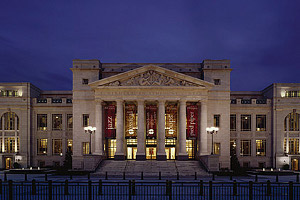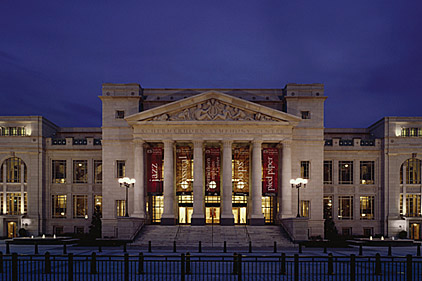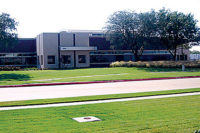
|
|
Knock-down air handlers installed at Schermerhorn Symphony Center deliver quiet operation and easy maintenance. |
MUSIC STOPS AT SYMPHONY CENTER
Designed as a world-class symphony hall, the 197,000-sq-ft, 1,844-seat neo-classical building sustained approximately $40 million in damages, from cleanup and reconstruction to lost business. Almost all of the damage was in the basement and sub-basement. When the river crested, the water table rose and the force of the water cracked the basement floor.
“We had too much rain too fast; there was nowhere for it to go,” said Eric Swartz, associate vice president of venue management, Nashville Symphony. “The water penetrated through the walls and the floors.”
Because the water rose so fast and so unexpectedly, there wasn’t time to retrieve the musical equipment stored in the basement, which filled with 22 ft of water overnight. The most officials could do was turn off electrical power. Two concert grand pianos were destroyed, as well as the console and blower for the $2.5 million Martin Foundation Concert Organ, a state-of-the-art catering kitchen, all of the building’s electrical equipment, and many prized orchestral instruments.
In addition to this heart-wrenching damage, floodwaters completely submerged ten of the building’s 11 AHUs, which were custom-designed to provide efficient airflow at the lowest possible sound levels. Nashville Symphony officials had seven months to complete the task. A grand re-opening was scheduled for New Year’s Eve, when world-renowned violin virtuoso Itzhak Perlman was scheduled to perform.
KNOCK-DOWN CONFIGURATION A MUST
Nashville Symphony hired American Constructors Inc., the locally based firm that built Schermerhorn Symphony Center, to oversee the immense retrofit project. The mechanical contracting firm, Lee Company, Franklin, TN, was responsible for the removal of the old equipment as well as installing new air-handling systems.
The six AHUs serving the performance hall were stacked top-and-bottom units because of the extra space required by the plenum fans. All of the units had to be cut out and removed piece by piece. With the location 20 to 30 ft below building grade, it would have been impossible to bring in motors or fan wheels to match the original units without knocking down one of the Symphony Center’s beautiful neoclassical exterior walls.
According to Jimmy Grun, senior project manager, Lee Company, the new AHUs had to be compact enough to meet the space needs of a new flood-remediation scheme and quiet enough to measure up to the Symphony Center’s stringent noise criteria. And it had to be done quickly.
Grun found his answer in a modular knock-down air handler from Huntair, Inc.
Integral to Huntair AHUs is Fanwall Technology — an array of smaller fans and motors in individual cube-shaped cells, each of which houses a fan, motor, and electrical connections. The number and configuration of these compact cells depend on the airflow and static pressure requirements of the particular air-handling application.
“When we learned about all the benefits of Huntair knock-down units and Fanwall Technology, we didn’t even vote on it,” said Swartz. “We all just said, ‘Yeah, let’s get that.’”
Because they are delivered completely knocked-down, all of the air handler pieces were brought into the building through the grated air opening 20 ft below grade. The individual pieces — fans, panels, and other components — were lowered using a lift crane. The modular Fanwall® cubes were moved individually into position without requiring any building damage and then stacked on site into the appropriate configurations.
The manufacturer’s representative firm, Tom Barrow Co., supplied the air handlers for Schermerhorn Symphony Center. Tom Barrow Co. also designed the custom configurations for the 10 separate locations in the Symphony Center’s mechanical system. After approximately 6,000 man-hours, 18 truckloads of palletized equipment were assembled into 10 new air handlers in the Symphony Center’s mechanical rooms.
DESIGN FEATURES KEEP NOISE DOWN
“Symphony Hall is an acoustically perfect little building,” said Swartz. “The reason the building works as well as it does is because everything that makes noise is buried in the basement. Our original AHUs were extremely superior pieces of equipment, with, among other things, double-lined ductwork to stop noise and vibration. However, those units were placed in the building when it was still a hole in the ground, so in addition to the retrofit issues, we needed something quiet.”
In most octave bands, the Fanwall units were more than a 15 decibel (dB) improvement over the Symphony Center’s old air handlers. As a result of this superior acoustical performance, Tom Barrow Co. was able to eliminate over 25% of the sound-attenuation structure installed in the ductwork of the air-handling systems, according to Blystone. In addition, the six air-handler systems serving the performance hall required much less sound-attenuating paneling than their much larger “stacked” predecessors.
In addition, the vertical space gained by the new configuration will help the center deal with future flooding. The new AHUs sit on structural steel platforms raised six feet off the floor of the mechanical rooms. Turbine pumps installed in the spaces beneath the units will allow those spaces to be used as sump pits in the event of a future flood. Thanks to these sump pits, enough water can be removed from the building so that a flood twice as large as the May 2010 event will not damage mechanical or electrical equipment.
Maintenance is also made easier.
“If a five-hp motor goes out, it’s a lot easier to replace than a 100-hp motor that weighs 1,000 pounds,” said Blystone. To further reduce maintenance, the direct-drive design requires no belts or sheaves. Nor does it require fan bearings, the HVAC component most likely to fail or deteriorate over time. The fan assembly also eliminates lubrication requirements with permanently sealed motor bearings.
“This was definitely a project that was staged properly,” said Swartz. “Not only did we meet some tough requirements, but everything showed up on time and on demand. Nobody wanted this disaster, but we now find ourselves way ahead of any replacement cycle we would have gone through.”
The grand re-opening and New Year’s Eve concert were a hit. With renowned violinist Itzhak Perlman as guest soloist, attendees enjoyed renewed appreciation for the restored Schermerhorn Symphony Center.





